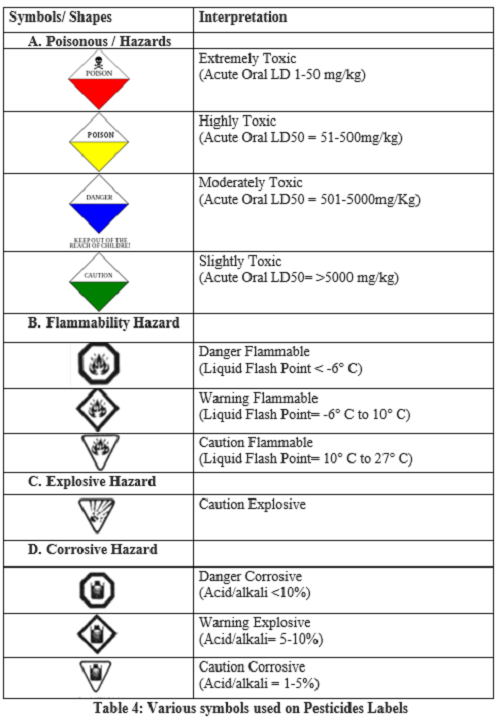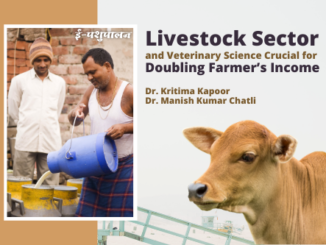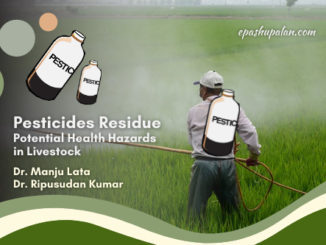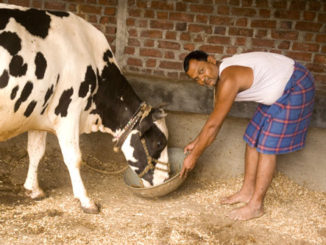Introduction
The United States Environment Protection Agency (USEPA) describes the term ‘PESTICIDE’ as any substance or mixture of substances intended for preventing, destroying, repelling or mitigating any pest. The first reported use of chemical pesticide in India began in 1948 when DDT was imported for malaria control and BHC for locust control. The establishment of BHC producing plant near Calcutta in 1952 paved a way for manufacturing of pesticides in India. Since then, with the advent of Green Revolution, the pesticide production in our country has bloomed from 5000 metric tonnes in 1958 to 102,240 metric tonnes in 1998. According to Ministry of Agriculture and Farmers Welfare, during 2019-20, India reported an alarming 61,702 metric tonnes use of chemical pesticides. Unfortunately, rampant use of these chemicals has given rise to several short-term and long-term adverse effects on health of humans as well as animals.
| Major Indian States in terms of Chemical Pesticide Consumption during 2019-2020 | |
| 1. Maharashtra | 12,783 Metric Tonnes |
| 2. Uttar Pradesh | 12,217 Metric Tonnes |
| 3. Haryana | 4,200 Metric Tonnes |
| Total Consumption in India (2019-20) | 61,702 Metric Tonnes |
TABLE 1: Source: Statistical Database of Directorate of Plant Protection, Quarantine &Storage; Department of Agriculture, Cooperation & Farmers Welfare; Ministry Of Agriculture & Farmers Welfare, Government of India

Major class of Pesticides used in India is Insecticides, whose extensive and indiscriminate use in agriculture has resulted in increase of insecticide toxicity cases in livestock population that cannot be overlooked. The major uses of pesticides include;
- To minimize the loss of agriculture produce caused by insects, rodents and other pests during storage
- Pesticides aid in increasing agriculture output as well as its quality by eliminating harmful weeds, rodents, pests, etc
- Pesticides are also used in animals to get rid of various vectors, exoparasites like tick, mites, etc., helminthes, etc.
- Pesticides are widely used domestically to control household pests.
- Pesticides are also used in various Public Health Programs including elimination of various disease vectors like mosquitoes, etc.
Since pesticides are designed to kill or adversely affect living organisms, by their very nature, they pose risk to humans, non-target plants and animals. They not only contaminate the ecosystem but also bio-accumulate in the food chain and can be traced in plant and animal tissues causing serious health. As per World Health Organization estimates, pesticides lead to one million pesticide poisoning cases and 20,000 deaths every year globally. Apart from this, non-judicious Pesticide usage is one of the major causes of environmental contamination, pesticide residues in milk, meat and other dairy products. Hence there is an urgent need to address the health hazards associated with dietary exposure of pesticides and other sources of pesticide poisonings, as well as its prevention and control strategies in Indian scenario.
Classification of Pesticides
The Pesticides contain a wide variety of substances which basically fall into following categories based on their target organisms and biological activity.
- Insecticides: Insecticides are any toxic substances which are used to kill, harm, repel or mitigate insects, their eggs or their larvae.
- Herbicides: Herbicides are toxic agents which are used to kill or inhibit the growth of unwanted plants, such as weeds, invasive species, etc. They are also known as weedicides
- Fungicides: Fungicides are the substances used to kill or inhibit the growth of moulds.
- Rodenticides: Rodenticides are the toxic substances which are used to kill rats, mice, moles and other rodents.
- Fumigants: Fumigants are the pesticides that exist as a gas or vapour at room temperature and maybe used as insecticides, fungicides, rodenticides or herbicides.
- Others: They include algaecides (to kill algae), miticides (to kill moths) and acaricides (to kill ticks)
| Insecticides | Herbicides | Rodenticides |
| i) Organochlorine E.g.: DDT, aldrin, dieldrin, endosulfan, lindane, etc
ii) Organophosphates E.g.: malathion, parathion, etc iii) Carbamates Carbaryl, aldicarb, etc. iv) Pyrethrins and Pyrethroides E.g.: allethrin, permethrin, cypermethrin, etc. |
i) Dinitro compounds Eg.: Dinitrophenol
ii) Bipyridinium compounds Eg: Paraquat iii)Phenoxyacetic acids Eg: 2,4-D, 2,4,5-T iv) Triazenes Eg: Atrazine, Propazine, etc v) Chloroalipathic acids Eg: Dalapan vi) Substituted ureas Eg: Diuron vii) Substituted dinitroanilines Eg: pendimethalin |
i) Inorganic agents Eg: zinc phosphide, Fluoroacetate
ii) Dicoumarol derivatives Eg: Warfarin iii) Glycosides Eg: Red Squill |
Table 2: Major Classes of Pesticides
Source: Veterinary Toxicolgy By Satish K. Garg
World Health Organization (WHO) has classified various pesticides based on the acute toxicity studies, which is as follows:
| Classification of hazardous level | Level name | LD50 Level in rats (mg/kg body weight) | |||
| Oral Route | Dermal Route | Classes of Toxicity | Classes of Toxicity Limits according to ADI* | ||
| Ia | Extremely Dangerous(ED) | <5 | <50 | A | ADI<0.0001 |
| Ib | Highly Dangerous(FD) | Mai-50 | 50-200 | B | 0.001<ADI<0.001 |
| II | Moderately Dangerous (MD) | 50-2000 | 200-2000 | C | 0.001<ADI<0.01 |
| III | Slightly Hazardous (LD) | >2000 | D | 0.01<ADI<0.1 | |
| U | Not known to have Acute Hazard (ND) | 5000 or more | E | 0.1<ADI | |
| *ADI= Acceptable Daily Intake (mg/kg body weight) | |||||
Table 3: Pesticide Classification By WHO, 2006
Most Consumed Pesticides in India (During 2005-06 to 2009-10)
- Sulphur (fungicide)
- Endosulfan (insecticide)
- Mancozeb (fungicide)
- Phorate (insecticide)
- Methyl Parathion (insecticide)
- Monocrotophos (insecticide)
- Cypermethrin(insecticide)
- Isoproturon (herbicide)
- Chlorpyrifos (insecticide)
- Malathion (insecticide)
- Carbendazim (fungicide)
- Butachlor (herbicide)
- Quinalphos (insecticide)
- Copper Oxychloride
- Dichlorvas (insecticide)
Sources and Causes of Pesticide Toxicity in Livestock
With the massive use of pesticides in agriculture and other practices, the instances of pesticide toxicity in farm animals and livestock have increased manifold. The livestock reared on or near agricultural farms can be said to be most susceptible to pesticide toxicity. The main sources of Pesticide poisoning in animals can be summarised as given below:
Through feed, fodder and water
- Feeding the animals with freshly sprayed fodder and feeds or contaminated concentrates (i.e. pesticide sprayed grains) which are unfit for human consumption may lead to pesticide poisoning in the farm animals. Grazing the animals on freshly treated crop fields and pastures is also the common cause of pesticide toxicity. Accidental ingestion from pesticide containers or storage sacks may result in pesticide poisoning.
- Drinking water from pesticide contaminated ponds due to effluents from fields or spraying or using empty pesticide containers as water troughs are major sources of pesticide toxicity in through water.
Through accidental licking
- The animals may lick the ectoparasiticides, sprayed on them for treatment of ticks, mites, etc, from their skin coat and its ingestion may ultimately lead to pesticide toxicity. These can also be absorbed through mucus membranes, eyes or abraded skin.
- The animals may also accidently lick the freshly sprayed walls or surfaces which may lead to adverse health effects
Intentional/ Malicious Poisoning
- The farm animals may be intentionally poisoned by mixing pesticides in their feed, fodder or water.
Common clinical signs and symptoms of Pesticide poisoning
Insecticide Poisoning is the most common of all pesticides toxicities. In general, organophosphate and carbamates insecticides are more toxic to warm-blooded animals and active for shorter periods of time than chlorinated hydrocarbons. Thus it becomes very necessary to recognize the signs of pesticide poisoning in animals and initiate prompt treatment when poisoning is suspected. In case an animal exhibits any signs of insecticide toxicity, history of the animal should be taken for 24 to 48 hours before onset of symptoms.
The common symptoms and signs exhibited by animals in poisoning of some common insecticides are:
Organochlorine Poisoning
Although the use of organochlorines has tremendously declined now-a-days, but they were one of the first synthetic organic insecticides to be used by mankind. Organochlorines mainly act on Central Nervous Systems and can be categorised as neurotoxins, although various other adverse effects on body are also seen. Some common symptoms of organochlorine poisoning are:
- Affected animal becomes timid, hypersensitive, apprehensive and exhibits restlessness or excitability
- Twitching of eyelids, face, neck, fore and hind parts of body
- Staggering gait or loss of control over movements
- Abnormal postures
- Vomiting
- Convulsions
- Respiratory failure
Organophosphate poisoning
Organophosphates are the chemical compounds which produce effects in animals by irreversibly inhibiting Cholinesterase. They are one of the major groups of pesticides used at present time. Common symptoms of organophosphate toxicity in Livestock are:
- Nasal Discharge, wheezing respiration and open mouth breathing in case of exposure of animal to vapours or aerosols
- Lachrymation, conjunctival hyperaemia and Constriction of pupil in case of exposure to eye
- Hyper excitation, Salivation, diarrhoea
- Muscle fasciculation, twitching, tremors, spasms
- Rigid and stiff gait
- Loss of reflexes
- Bradycardia and weak pulse
- Coma
- OPIDN (Organophosphate Insecticide Delayed Neuropathy) in case of single or cumulative doses of some organophosphates
Carbamate Poisoning
Carbamates are widely used in agricultural, veterinary and household practices and they reversibly inhibit Cholinesterase enzyme, thus producing symptoms by overstimulation of cholinergic system. Signs and symptoms are similar to organophosphate poisoning, which include:
- Nasal discharge and even dyspnoea in extreme poisoning
- Lachrymation, Pupillary constriction
- Hypersalivation
- Muscle tremors, twitches and spasms
- Incoordination
- Ataxia and recumbancy
- Delayed Neuropathy is not observed here
Pyrethroids Poisoning
Pyrethrins are natural insecticides obtained from extracts of Chrysanthemum flowers. Pyrethroids are their synthetic analogues. Absorption of these from skin of mammals is poor, so toxicity is rare. But poisoning can result due to excessive ingestion as ectoparasiticides. They usually interfere with Nervous system and produce following signs:
- Hyperexcitability, restlessness
- Incoordination
- Excessive salivation
- Mucoid nasal discharge
- Regurgitation of ruminal contents
- Diarrhoea
- Tremors, seizures and paralysis in case of severe toxicity
Prevention of Pesticide Toxicity
An old famous proverb, “Prevention is better than cure”, stands cent per cent true in case of Pesticide poisoning too. Nothing is better than to use the pesticides cautiously and take proper precautions to prevent any mishappening to the livestock as well as humans. The precautions to be taken while handling and usage of pesticides are as follows:
- Selection and application of Pesticides
- The pesticides to be used should be carefully selected after consult from extension agents and, keeping in mind the field requirements, pests to be targeted and the availability of application and Personal protective equipments.
- Before starting application of pesticides, read all the labels and manuals again. Make note of the target pest, area of application, necessary PPE, special warnings, First aid measures, Rate of application etc, and use accordingly.
- Cover all the animal feed and water troughs to prevent their contamination.
- Don’t mix and load pesticides where animals can have easy access to it. Also avoid spilling of pesticides on ground where animals may lick it.
- Pastures and forages should only be treated with pesticides which don’t contaminate the crops. It should be kept in mind that prescribed number of days (or as written on the label) should be elapsed before allowing animals to graze.
- The equipments and sprayers should be cleaned properly to avoid accidental licking by the animals. The cleaning are should be separate and the drainage water should not be dumped into streams or other water sources.
- In case of using pesticides to treat animals, consult a veterinarian first. Sick and stressed animals should not be treated with certain pesticides. Lactating, Pregnant and Young animals are most susceptible to pesticide poisoning.
- Storage of Pesticides
- Storage area of pesticides should be locked, dry, well ventilated, far from feed and fodder storage area and away from the reach of animals.
- The building materials should be fire resistant and proper temperature is to be maintained inside to prevent overheating. Exhaust Fan can be installed in the storage area.
- The containers should be leak-proof and all the informative labels on the containers should be kept intact.
- Empty pesticide containers should not be used as feeding or water troughs for animals. They should be disposed of as soon as possible according to the instructions given on the label.
- Miscellaneous
- Proper prescribed time interval should be observed while successive applications of pesticides
- Rate and amount of pesticide application should be kept in mind
- Adequate personal protective equipments, masks, etc should be used by farmers while using pesticides

| The content of the articles are accurate and true to the best of the author’s knowledge. It is not meant to substitute for diagnosis, prognosis, treatment, prescription, or formal and individualized advice from a veterinary medical professional. Animals exhibiting signs and symptoms of distress should be seen by a veterinarian immediately. |






Be the first to comment